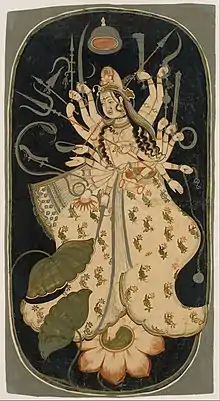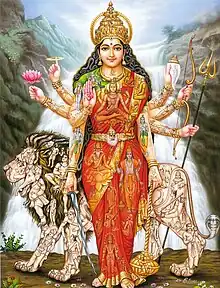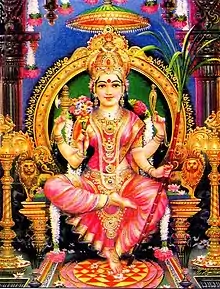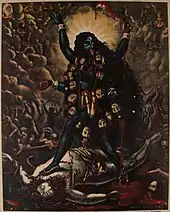Mahadevi
Mahadevi (Sanskrit: महादेवी, IAST: Mahādevī), also referred to as Adi Parashakti, Adi Shakti, and Abhaya Shakti, is the supreme goddess in the Shaktism sect of Hinduism.[3][4] According to this tradition, all Hindu gods and goddesses are considered to be manifestations of this single great Goddess, who is comparable to the deities Vishnu and Shiva as Para Brahman.[5] Vaishnavas consider her to be Lakshmi,[6] Shaivas consider her to be Parvati, Durga, Lalita and Kali,[7] while Shaktas consider her to be Durga, Tripura Sundari, Bhuvaneshvari, and Kali. Author Helen T. Boursier says: "In Hindu philosophy, both Lakshmi and Parvati are identified with the great goddess—Mahadevi—and the Shakti or divine power".[8]
| Part of a series on |
| Hinduism |
|---|
 |
| Mahadevi | |
|---|---|
 | |
| Devanagari | महादेवी/आदिशक्ति/पराशक्ति |
| Sanskrit transliteration | Mahādevī / Ādiśakti / Parāśakti |
| Affiliation |
|
| Abode | Manidvipa |
| Mantra | Ōm āim hrīm śrīm klīm[1] |
| Weapon | Devi Chakra, Pasha, Ankusha, Trishula (trident), Panchajanya |
| Symbol | Om, Sri Yantra |
| Mount | Lion and Tiger |
| Texts | Devi Mahatmya, Devi-Bhagavata Purana, Kalika Purana, Lalita Sahasranama, Soundarya Lahari, Shiva Purana, Shakta Upanishads such as the Devi Upanishad[2] |
| Festivals | Navaratri, Vasanta Panchami, Durga Puja, Lakshmi Puja, Kali Puja, Durga Ashtami, Lalita Jayanti, Adi-Puram |
Shaktism

Durga one of forms of Mahadevi
Shaktas conceive the Goddess as the supreme, ultimate, eternal reality of all existence, or same as the Brahman concept of Hinduism. She is considered to be simultaneously the source of all creation, its embodiment and the energy that animates and governs it, and that into which everything will ultimately dissolve. She has manifested herself as Shiva in male form. Her half is Shiva.[9]
Importance
In the Devi Gita of Devi Bhagavatam, it is suggested that before incarnating as Parvati, she appeared to King Himalaya and revealed divine, eternal knowledge to him. She explained herself, in the words of the Vedas, as having neither beginning nor end. She is the only, eternal truth. The whole universe is her creation. She is the only victor and the manifestation of victory itself. She is a manifested, un-manifested and transcendent divinity. She then displayed her scarcely seen form to him: Satyaloka was located in her forehead; the created universe were her hairs; the sun and moon were her eyes; in her ears were the four directions; the Vedas were her words; death, affection and emotion were her teeth; maya was manifested by her smile.[10] The goddess Parvati as Kushmanda gives birth to the universe in the form of a cosmic egg which manifests as the universe. Ultimately, Adi Shakti herself is the zero energy which exists even after destruction of the universe and before its creation.[7]
Vedas
The Vedas name numerous forms of goddess such as Devi (power), Prithvi (earth), Aditi (cosmic moral order), Vāc (sound), Nirṛti (destruction), Ratri (night) and Aranyani (forest); bounty goddesses such as Dinsana, Raka, Puramdhi, Parendi, Bharati and Mahi are among others are mentioned in the Rigveda.[11]
The Devīsūkta of the Rigveda (10.125.1 to 10.125.8) is among the most studied hymns declaring that the ultimate reality is a goddess:[12][13]
I have created all worlds at my will without being urged by any higher Being, and dwell within them. I permeate the earth and heaven, and all created entities with my greatness and dwell in them as eternal and infinite consciousness.
Upanishads
Shakta Upanishads are a group of minor Upanishads of Hinduism related to the Shaktism theology. There are eight Shakta Upanishads in the Muktika anthology of 108 Upanishads.[16] The Shakta Upanishads are notable for declaring and revering the feminine as the Supreme, the primal cause and the metaphysical concepts in Hinduism called Brahman and Atman (soul).[17][18]
Devi Bhagavata Purana
The Devi Bhagavata Purana described her in the form of Bhuvaneshvari. It mentioned that Shiva worshipped and meditated on Adi Parashakti for thousands of years, using the beeja mantra "Hreem". The Goddess Adi Parashakti is also considered to be both the truly supreme spirit without form (Param Atman) and Saguna with form. In her Saguna form she is described as the Mother of the Universe and is residing in Sarvaloka Manidweepa above all of the other realms. She is the Great Goddess, and all other goddesses and even all the Gods are her various forms, says the Devi Gita. In Devi Mahatmyam, Trimurti and demigods praises Adi Shakti.
गायन्ती दोलयन्ती च बालभावान्मयि स्थिते ।
सेयं सुनिश्चितं ज्ञातं जातं मे दर्शनादिव ।।
कामं नो जननी सैषा शृणु तं प्रवदाम्यहम् ।
अनुभूतं मया पूर्व प्रत्यभिज्ञा समत्थिता ॥Now I recollect all what I felt before at Her sight & recognize that She is the Bhagavati. These very things I now communicate to you. Hear attentively that She is this Lady & She is our Mother.— Srimad Devi Bhagavatam Canto 03, Chapter 03, Verse 66:67
Cosmogony
In the third canto of the Srimad Devi Bhagavatam, Devi addressed the Trimurti as follows:
There is oneness always between me & the Purusha; there is no difference whatsoever at any time between me & the Purusha (the Supreme Self). Who is I, that is Purusha; who is Purusha, that is I. The difference between force & the receptacle of force is due to error. He who knows the subtle difference between us two, is certainly intelligent; he is freed from this bondage of Samsara; there is no manner of doubt in this. The One Second less Eternal ever lasting Brahman substance becomes dual at the time of creation.[19]
— Srimad Devi Bhagavatam Canto 03, Chapter 06, Verse 02:03
According to the Tripura Rahasya, only Mahadevi was existed in her form of Tripura Sundari before the beginning of the universe. She is supposed to have created the Trimurti, and began the creation of the universe.[20]
Long ago, at the time of creation, Tripura the Universal Consciousness was all alone. There was nothing other than Her. She, the embodiment of Power, who is Self independent wanted to create; the desire developed. From desire, knowledge was born & then action. From Her 3 glances the 3 gods were born. Pashupati represented desire, Hari knowledge & Brahma action. They were looked at by Sankari & became naturally powerful & Truth abiding.
— Shri Tripura Rahasya (Mahatmya Khanda), Chapter 10, Verses 18 to 22
Shaivism
The Shiva Purana says Adi Parashakti incarnated in materialistic form as Parama Prakriti from the left half of Lord Shiva i.e.Parabrahman during the beginning of the Universe. The Linga Purana states that Adi Shakti brings forth the evolution of life in every Universe through the union of every Shiva and Parvati in all of the Universes.[21][22]
That alone, Paramesvari of three attributes, creates the universe; she alone sustains it and she alone destroys it at the proper time.
— J.L.Shastri, Shiva Purana (Umasamhita), Chapter 45, Verse 49
I bow to the great Maya, the Yogic slumber, Uma, Sati, Kalaratri, Maharatri, Moharatri, greater than the greatest, the mother of the three deities, the eternal, the bestower of the fruits of the cherished desires of the devotees, the protectress of the gods and the ocean of mercy.
— J.L.Shastri, Shiva Purana (Umasamhita), Chapter 45, Verses 58-59
Vaishnavism

The goddess Lakshmi is revered as Mahadevi in the Vaishnavite tradition, extolled to possess a thousand names and qualities.[23] Various texts like the Garuda Purana, Bhagavata Purana, and Lakshmi Tantra refer to Lakshmi as Mahadevi.
Lakshmi is worshipped as maya, the delightful delusion, the dream-like expression of divinity that makes life comprehensible, hence worth living. She is true shakti, energy, boundless and bountiful.[24]
इच्छारूपां भगवतस्सच्चिदानन्दरूपिणीम् । सर्वज्ञां सर्वजननी विष्णुवक्षस्स्थलालयाम् । दयालुमनिशं ध्यायेत्सुखसिद्धिस्वरूपिणीम् ॥
I always meditate on that Goddess who has the form of pleasure & salvation,
Who takes that form that is dear to the God, who is the form of divine joy, Who knows everything, who is the mother of all,
Who lives on the chest of Lord Vishnu & who is very merciful.
— Vyasa, Lakshmi Sahasranama Stotram, Skanda Purana
Forms



Mahadevi can take various forms including Kali, Durga, and Chandi.
According to Shakta traditions, Devi is the ultimate goddess and complete physical embodiments of Adi Parashakti. Brahma, Vishnu, Shiva of this Universe are her subordinates and cannot function without her power. Thus, she is considered the supreme Goddess and primary deity in Shaktism as she is the nearest representative of Adi Parashakti who further incarnated as Parvati. Whatever deity one is worshiping they are, ultimately, worshiping Adi Parashakti.[7] According to the Srikula tradition in Shaktism, Tripura Sundari is the foremost of the Mahavidyas, the highest aspect of Mahadevi and also the primary goddess of Sri Vidya. The Tripura Upanishad places her as the ultimate Shakti (energy, power) of the universe.[27]
In Vaishnavism, Lakshmi is traditionally worshipped as secondary to her consort Vishnu, and represents the bliss of a settled and domestic life. However, in Shakta traditions Lakshmi either is, or is a representation of, the supreme deity. In texts such as the Lakshmi Tantra, she is both the creator and the destroyer. In her capacity as Mahalakshmi, she is synonymous with Mahadevi.[28]
In Shaivism, the Devi Parvati is the complete incarnation of Adi Parashakti.[29] Parvati was Sati in her previous birth. Sati was also a direct incarnation of Adi Parashakti. However, Sati died and was reborn as Parvati. Parvati is shown as kind and loving mother goddess.
The ten Mahavidyas
The Mahavidyas are ten Tantric goddesses, or aspects, of Mahadevi that show her nature and ability to manifest in different forms for various purposes. The word Mahavidya means 'Great Knowledge' and the epithet 'Dasamahavidyas', the ten great mantras, is also used to refer to them.[30] The Mahavidyas have been identified as a group since the tenth century CE[30] and usually includes, in order, Kali, Tara, Tripura Sundari, Bhuvaneshvari, Chinnamasta, Bhairavi, Dhumavati, Bagalamukhi, Matangi, and Kamala.[31] Texts such as Guhydtiguhya-tantra, Todala-tantra, and Mundamala-tantra compare the ten Mahavidyas to the ten avatars of Vishnu. According to Kinsley, though the Mahavidyas serve less cosmic roles than the avatars of Vishnu, their purpose is to show that through her various forms Mahadevi pervades all aspects of reality.[31]
Iconography
Adi Parashakti is generally seen as an abstract goddess but her appearance is described in the Devi Bhagavata Purana, Kalika Purana, Markandeya Purana-Devi Mahatmya, Brahmanda Purana-Lalita Sahasranama, and the Tripura Rahasya. According to the Devi Bhagavata Purana, the goddess once invited the Trimurti to Manidvipa. The Trimurti saw the supreme goddess Bhuvaneshvari sitting on a jeweled seat on a throne. Her face contained the radiance of millions of stars and her celestial beauty was so great, that the Trimurti were not able to look at her. She carries the Abhaya and Varada Mudra, Pasha, and Ankusha.[29]
Epithets
Mahadevi is known by many names. She is commonly known as Mulaprakrti ('she who is primordial matter') and Mahamaya ('she who is the great maya').[29] The Devi Bhagavata Purana and Lalita Sahasranama describe Mahadevi's numerous epithets. These names include her divine and destructive characteristics.[29] In the Devi Bhagavata Purana she is described as 'the mother of all', 'the life force in all beings', and 'she who is supreme knowledge'. The Lalita Sahasranama also describes her as Visvadhika ('she who transcends the universe'), Sarvaga ('she who is omnipresent'), Vishvadharini ('she who supports the universe'), Raksasaghni ('she who slays demons'), Bhairavi ('the terrible one'), and Sarhharini ('she who destroys').[29] Mahadevi's destructive features are further described in a hymn called Aryastava, calling her Kalaratri ('night of death') and Nistha ('she who is death').[29]
Attributes
Mahamaya
In the first episode of the Devi Mahatmya Mahadevi is referred as Mahamaya, meaning the great illusion. According to Thomas Coburn, this reference affirms her status as a Goddess.[32]
In popular culture
- The Tenth Riddle, a novel by Sapan Saxena, is based on Mahadevi and her ten forms or Mahavidyas.[33]
References
Citations
- Narayanananda 1960, p. 50.
- Jones, Constance; Ryan, James (2014). Encyclopedia of Hinduism. Infobase Publishing. p. 399. ISBN 978-0816054589.
- Vanamali (21 July 2008). "3. Mahadevi". Shakti: Realm of the Divine Mother. Simon and Schuster. ISBN 978-1-59477-785-1.
- Dalal, Roshen (6 January 2019). The 108 Upanishads: An Introduction. Penguin Random House India Private Limited. ISBN 978-93-5305-377-2.
- Hay, Jeff (6 March 2009). World Religions. Greenhaven Publishing LLC. p. 284. ISBN 978-0-7377-4627-3.
- Pintchman, Tracy (21 June 2001). Seeking Mahadevi: Constructing the Identities of the Hindu Great Goddess. SUNY Press. p. 9. ISBN 978-0-7914-5007-9.
- Bonnefoy 1993, p. 95.
- Boursier 2021, p. 30.
- Dikshitar 1999, pp. 77–78.
- "The Devi Gita index". Sacred-texts.com. Retrieved 5 August 2012.
- Kinsley, David (1988). Hindu Goddesses: Vision of the Divine Feminine in the Hindu Religious Traditions. University of California Press, ISBN 0-520-06339-2.
- McDaniel 2004, p. 90.
- Brown 1998, p. 26.
- McDaniel 2004, p. 90; Brown 1998, p. 26.
- Sanskrit original see: ऋग्वेद: सूक्तं १०.१२५;
for an alternate English translation, see: The Rig Veda/Mandala 10/Hymn 125 Ralph T.H. Griffith (Translator); for - Deussen 1997, p. 556.
- McDaniel 2004, pp. 89–90.
- Brooks 1990, pp. 77–78.
- "Cosmology". Integral Yoga of Sri Aurobindo & The Mother. 9 May 2009. Retrieved 13 November 2021.
- Rao, T.B. Lakshmana (2011). Shri Tripura Rahasya (Mahatmya Khanda). Sri Kailasamanidweepa Trust, Bengaluru. p. 108.
- Shastri, J. L. (1970). English translation by J. L. Shastri (ed.). The Shiva Purāṇa (includes glossary) – via Wisdom Library.
- Shiva Mahapurana | Gitapress Gorakhpur
- "Lakshmi Sahasranama Stotram - Hindupedia, the Hindu Encyclopedia". www.hindupedia.com. Retrieved 8 May 2022.
- Pattanaik, Devdutt (2002). Lakshmi, the Goddess of Wealth and Fortune: An Introduction. Vakils, Feffer and Simons. ISBN 978-81-8462-019-1.
- Vasantānanta, Nā Irāmaccantiraṉ (1993). Sri Lalita Sahasranamam: Nama-wise Commentary in English with Text in Sanskrit. p. 358.
- Śaṅkarācārya; Tapasyananda; Lakṣmīdhara (1987). Saundarya-lahari of Sri Sankaracarya: with text and translation, and notes based on Lakṣmīdhara's commentary. Sri Ramakrishna Math. p. 70. ISBN 9788171202447.
- Mahadevan 1975, p. 235.
- Dalal 2010, p. 206.
- Kinsley 1998, p. .
- Foulston, Lynn; Abbott, Stuart (2009). Hindu goddesses: beliefs and practices. Brighton: Sussex Academic. pp. 116–117. ISBN 978-1-902210-43-8.
- Kinsley, David (1997). Tantric Visions of the Divine Feminine. University of California Press. pp. 9, 21, 22. ISBN 978-0-520-91772-9.
- Hawley, John Stratton; Wulff, Donna Marie (1998). Devī: Goddesses of India. Motilal Banarsidass Publ. p. 33.
- "on writing a book with the core theme of sacred feminism - The News Now". www.thenewsnow.co.in. Retrieved 12 July 2022.
Works cited
- Bonnefoy, Yves (1993). Asian Mythologies. University of Chicago Press. ISBN 978-0-226-06456-7.
- Boursier, Helen T., ed. (2021). The Rowman & Littlefield Handbook of Women's Studies in Religion. Rowman & Littlefield. ISBN 978-1538154458.
- Dalal, Roshen (2010). The Religions of India: A Concise Guide to Nine Major Faiths. India: Penguin Books. ISBN 978-0143415176.
- Dikshitar, V. R. Ramachandra (1999) [1942]. The Lalitā Cult. Delhi: Motilal Banarsidass. ISBN 978-8120814981.
- Kinsley, David (1998). Hindu Goddesses: Vision of the Divine Feminine in the Hindu Religious Traditions. Motilal Banarsidass. ISBN 978-81-208-0394-7.
- Mahadevan, T. M. P. (1975). Upaniṣads: Selections from 108 Upaniṣads. Motilal Banarsidass. ISBN 978-81-208-1611-4.
- Narayanananda, Swami (1960). The Primal Power in Man: Or, The Kundalini Shakti. India: N. K. Prasad. ISBN 978-0787306311.
- Rajeswari, D. R. (1989). Sakti Iconography. India: Intellectual Publishing House. ISBN 978-8170760153.
Further reading
- Brown, C. Mackenzie (1990). The Triumph of the Goddess: The Canonical Models and Theological Visions of the Devi-Bhagavata Purana. State University of New York Press. ISBN 978-0791403648.
- Brown, C. Mackenzie (1998). The Devī Gītā: The Song of the Goddess: A Translation, Annotation, and Commentary. State University of New York Press. ISBN 978-0791439401.
- Rao, S. K. Ramachandara (2012). Lalitaarchana-Chandrika, Hymns to Lalita, Form of Tripurasundari. Lala Murari Lal Chharia Oriental Series. Delhi: Divine Books. ISBN 978-93-81218-45-7.


